We speak with Paul Hoveman, Managing Director of Buckleys (UVRAL) Ltd about their leak detection equipment and his advice for architects.
Buckley’s is an interesting company. Originally set up in 1926, they have specialised in testing and inspection equipment since the early ‘60s, much of it used in the petrochemical industry, but also in hospitals, for equipment used in keyhole surgery. They’ve been producing electronic leak detection equipment for roofs since 1990, where they are applying their considerable technical expertise to a subject that has been a challenge for architects for over a century.
What types of Leak Detection Equipment are Available?
Buckley’s make two types of electronic leak detection equipment, which represent the best technologies available for leak detection in roofs; the Dry Test System and the Wet Test (also known as Vector Mapping or Earth Leakage) System. Both work by testing the insulative qualities, in that we are looking for breaches/mechanical damage of the membrane against conductive qualities of another element, either water or foil faced insulation board.
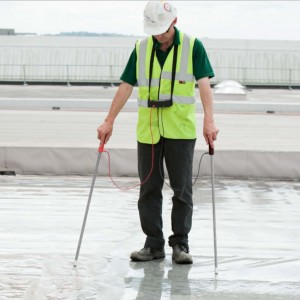 The Wet Roof system is a low voltage system, with Buckleys version developed in 2008 and is used worldwide. Wet Roof testing requires the roof surface to be soaking wet, as transmission of electricity through the water in the leak source provides the signal that there is a leak. The operator surrounds the area to be tested with a trace wire and uses two electrodes and a pulse generator to send an electrical pulse through the roof surface. Like detecting the ripples from a pebble thrown into a pool, a direction finder then directs the operator towards the fault in the surface that is producing the leak.
The Wet Roof system is a low voltage system, with Buckleys version developed in 2008 and is used worldwide. Wet Roof testing requires the roof surface to be soaking wet, as transmission of electricity through the water in the leak source provides the signal that there is a leak. The operator surrounds the area to be tested with a trace wire and uses two electrodes and a pulse generator to send an electrical pulse through the roof surface. Like detecting the ripples from a pebble thrown into a pool, a direction finder then directs the operator towards the fault in the surface that is producing the leak.
The Dry Roof System has been in use since the 1990s and uses high voltage; here the roof surface must be completely dry as the system uses the high voltage to jump in air and identify the fault. After setting up the test area, the operator sweeps an electrode over the roof and an audible and visible alarm is triggered, pointing directly to where the breach/damage has occurred.
What Roof Materials work with Wet and Dry Leak Detection Equipment?
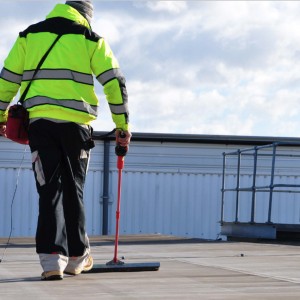
This wet and dry roof detection equipment depends on the ‘dielectric strength’ of the membrane they are testing.
They work well on
They aren’t suitable for EPDM roofs as EPDM conventionally contains a large amount of carbon, which makes it a poor insulator. White EPDM does not contain so much carbon and therefore may be suitable for leak detection. Buckley’s have a growing library of materials that have been tested for use with their equipment. Get in touch with us if you have any questions about a particular roof build up.
Leak Detection – Advice for Architects
There are three situations in which architects will need to deal with leaks in flat roofs.
- Specifying the testing of an installation;
- A new leak discovery;
- Advising on an old leaking roof.
Specifying Leak Detection in Flat Roofs
If you are specifying electronic roof detection for a roof you are designing, be aware that the circumstances in which the roof is tested will determine the effectiveness of the test. Dry testing can be carried out as soon as a roof is laid, but if wet testing is to be used, it will only detect leaks once some weathering has occurred, so that water is able to permeate through any leaks, and the roof must have a totally wet surface. If you’re working with us on the design of your roof we will advise on the correct wording to use in your specification.
Testing an existing roof for leaks
If your client presents you with a building with a leaky flat roof, or if a leak develops in a roof with which you are involved, there are some key questions to answer. Where is the water getting in? Is it a small leak that can be repaired, or are there several leaks, in which case would it be more effective to either over-roof or re-roof the building?
Electronic leak detection is an aid the answering these questions and informing decisions about which is the most cost effective approach to deal with the leak. Independent roofing survey companies can provide roofing detection advice, manufacturers may provide this service, and some roof installers will carry out surveys as part of a repair service. However in any case it is essential that the operators are properly trained and use the equipment properly, and in the right weather conditions. For dry testing, you need the surface to be completely dry, and an early coating of dew in the spring, or moist autumn or winter conditions can preclude dry testing unless there is a good dry wind to clear any moisture. Conversely in wet testing the surfaces to be tested must be completely wet.
Like any manufacturer of a quality product, Paul is keen that his equipment is used properly. Buckley’s provide training as part of their service to all purchasers of their equipment, and the company is working with both SPRA and NFRC (of which they are members) to help develop guidelines for and improve the training in leakage testing. “This can only improve the credibility of the industry, and everyone will benefit,” he says.

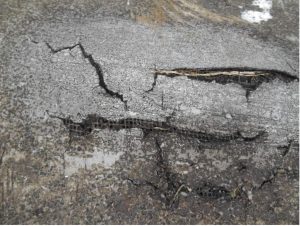
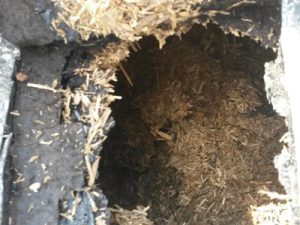
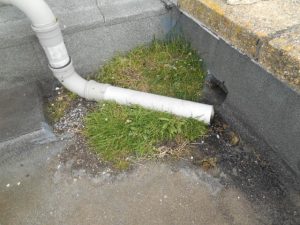
21 comments
I’m interested in more information about your equipment and cost
This sounds like great equipment. Buckleys has specialised in the manufacture of test and inspection equipment since around the 1960’s. Continuous investment in research and development has resulted in the comprehensive range of high/low voltage equipment available today. The leak detectors, as mentioned above but also includes DC holiday detectors and cable testers, AC spark testers, wet-sponge testers and a range of sub-sea inspection equipment.
We offer this service to all roofing contractors UK wide and also offer in depth training courses at our training centre in the North west
Very interested in your detector was is the cost of the training and where do you do the training
I’m interested in training for this and would like to know the cost to train for this and further details etc
Please email me details of training and courses available.
many thanks
Lindsey
interested in roof spark high voltage leak detection “broom”
data and price
thank you
ami shefet
Hi,
My company undertakes non-invasive leak detection looking for hidden plumbing leaks. We also undertake investigations and surveys looking for construction defects causing damp and water ingress. Increasingly, we are looking into flat roof problems. I would be very interested to hear more about your flat roof leak detection kit, and training packages. We have an engineer willing and eager to start!
Training sounds good, may sign up….
I would like to know more about leak detection training and costs etc ,thanks
I’d be interested in doing any courses offered for leak detection
Latest leak detection equipment are very essential in detecting leaks. Thank you Mr. Hoveman for this advice.
Thank you for this article, https://www.singleply.co.uk. We have used Buckley’s equipment for about 4 years now and has stood us in good stead when doing leak detection in London for our customers. Customers prefer non-invasive leak detection equipment but what we do find sometimes is that if they cannot see the damage, then they are often reluctant to get us to do the follow-up work. I suppose non-invasive leak detection techniques can have a downside however Buckley’s flat roof leak detection equipment has literally saved us thousands of employee hours over the last 4 years or so.
The next step is your leak detection ”broom” and more training courses for my staff!
Interested !!
What’s the price
And is there a course please provide more information thank you
What does Buckley dry leak detector cost
Hi
We have set up a roofing division which will provide maintenance on schools and pubs across the north west. We’re looking for training in the leak detection and purchase of a machine.
Thanks
John. 07936698815
Interested in courses and cost of equipment please advise cheers Dave heath
Do you know of any company in the Edinburgh area using this method of leak detection?
Thank you for providing an in-depth insight into Buckleys’ leak detection equipment and advice for architects. I’m curious to know what other techniques can be used to detect leaks in roofs aside from electronic leak detection.
can these detection systems be used on lead covered flat roofs